Hyundai Azera 2017 Owner's Manual
Manufacturer: HYUNDAI, Model Year: 2017, Model line: Azera, Model: Hyundai Azera 2017Pages: 520, PDF Size: 16.33 MB
Page 501 of 520
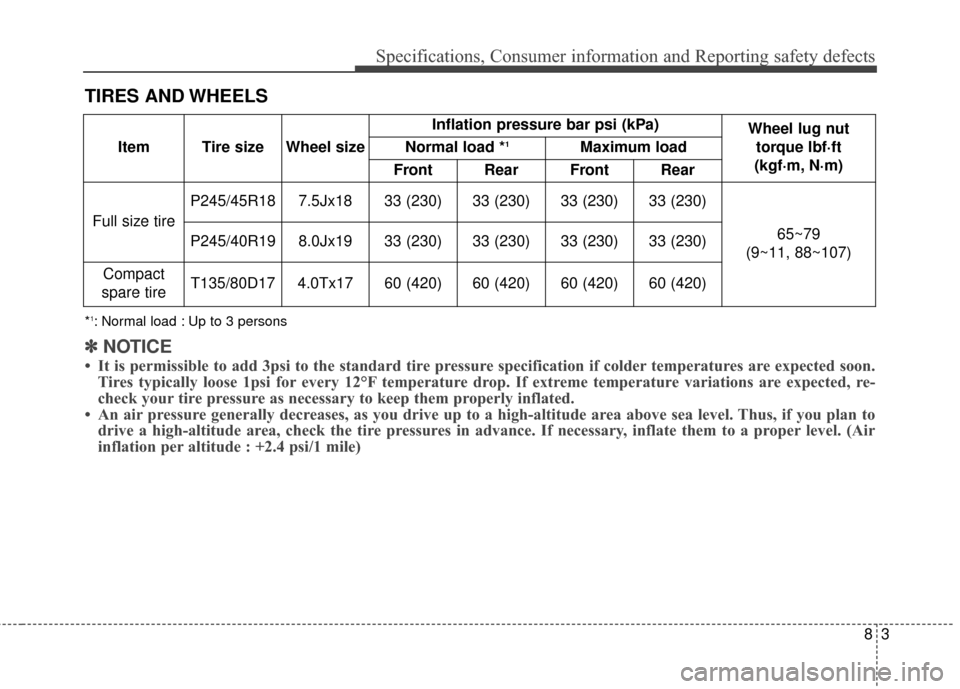
83
Specifications, Consumer information and Reporting safety defects
TIRES AND WHEELS
*1: Normal load : Up to 3 persons
Item Tire size Wheel sizeInflation pressure bar psi (kPa)
Wheel lug nut
torque lbf·ft
(kgf·m, N·m)
Normal load *1Maximum load
Front Rear Front Rear
Full size tire P245/45R18 7.5Jx18 33 (230) 33 (230) 33 (230) 33 (230)
65~79
(9~11, 88~107)
P245/40R19 8.0Jx19 33 (230) 33 (230) 33 (230) 33 (230)
Compact
spare tire T135/80D17 4.0Tx17 60 (420) 60 (420) 60 (420) 60 (420)
✽
✽
NOTICE
• It is permissible to add 3psi to the standard tire pressure specification if colder temperatures are expected soon.
Tires typically loose 1psi for every 12°F temperature drop. If extreme temperature variations are expected, re-
check your tire pressure as necessary to keep them properly inflated.
• An air pressure generally decreases, as you drive up to a high-altitude area above sea level. Thus, if you plan to drive a high-altitude area, check the tire pressures in advance. If necessary, inflate them to a proper level. (Air
inflation per altitude : +2.4 psi/1 mile)
Page 502 of 520
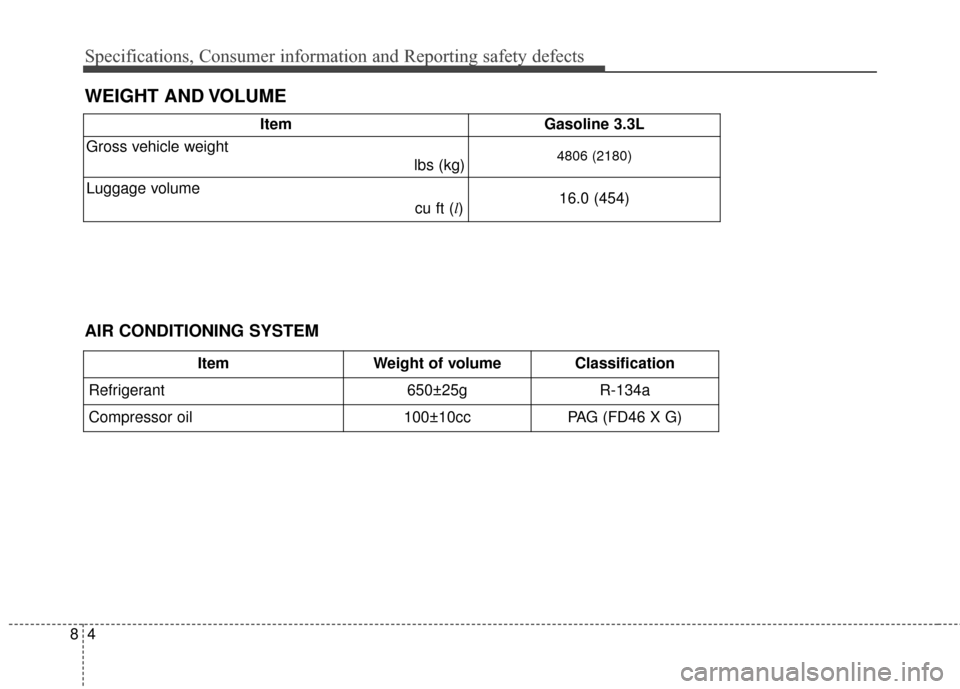
Specifications, Consumer information and Reporting safety defects
48
WEIGHT AND VOLUME
ItemGasoline 3.3L
Gross vehicle weight lbs (kg)
4806 (2180)
Luggage volume
cu ft (l)16.0 (454)
AIR CONDITIONING SYSTEM
ItemWeight of volumeClassification
Refrigerant650±25gR-134a
Compressor oil100±10ccPAG (FD46 X G)
Page 503 of 520
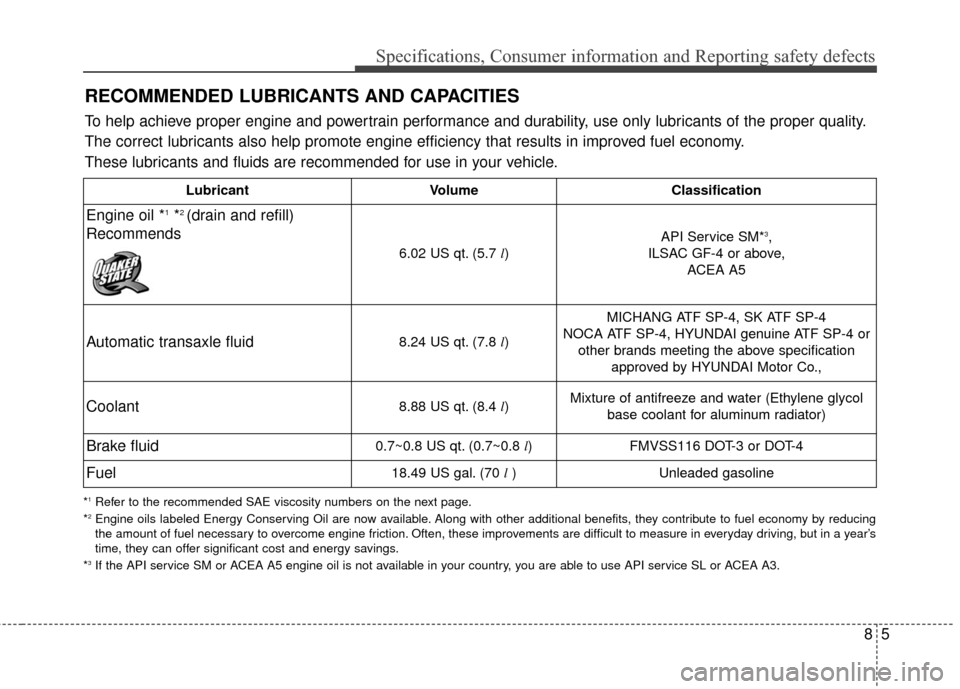
85
Specifications, Consumer information and Reporting safety defects
RECOMMENDED LUBRICANTS AND CAPACITIES
*1Refer to the recommended SAE viscosity numbers on the next page.
*2Engine oils labeled Energy Conserving Oil are now available. Along with other additional benefits, they contribute to fuel econo my by reducing
the amount of fuel necessary to overcome engine friction. Often, these improvements are difficult to measure in everyday driving, but in a year’s
time, they can offer significant cost and energy savings.
*
3If the API service SM or ACEA A5 engine oil is not available in your country, you are able to use API service SL or ACEA A3.
To help achieve proper engine and powertrain performance and durability, use only lubricants of the proper quality.
The correct lubricants also help promote engine efficiency that results in improved fuel economy.
These lubricants and fluids are recommended for use in your vehicle.
Lubricant Volume Classification
Engine oil *1*2 (drain and refill)
Recommends
6.02 US qt. (5.7 l) API Service SM*
3,
ILSAC GF-4 or above, ACEA A5
Automatic transaxle fluid8.24 US qt. (7.8 l) MICHANG ATF SP-4, SK ATF SP-4
NOCA ATF SP-4, HYUNDAI genuine ATF SP-4 or other brands meeting the above specification approved by HYUNDAI Motor Co.,
Coolant8.88 US qt. (8.4 l)Mixture of antifreeze and water (Ethylene glycol
base coolant for aluminum radiator)
Brake fluid0.7~0.8 US qt. (0.7~0.8 l) FMVSS116 DOT-3 or DOT-4
Fuel18.49 US gal. (70 l)
Unleaded gasoline
Page 504 of 520
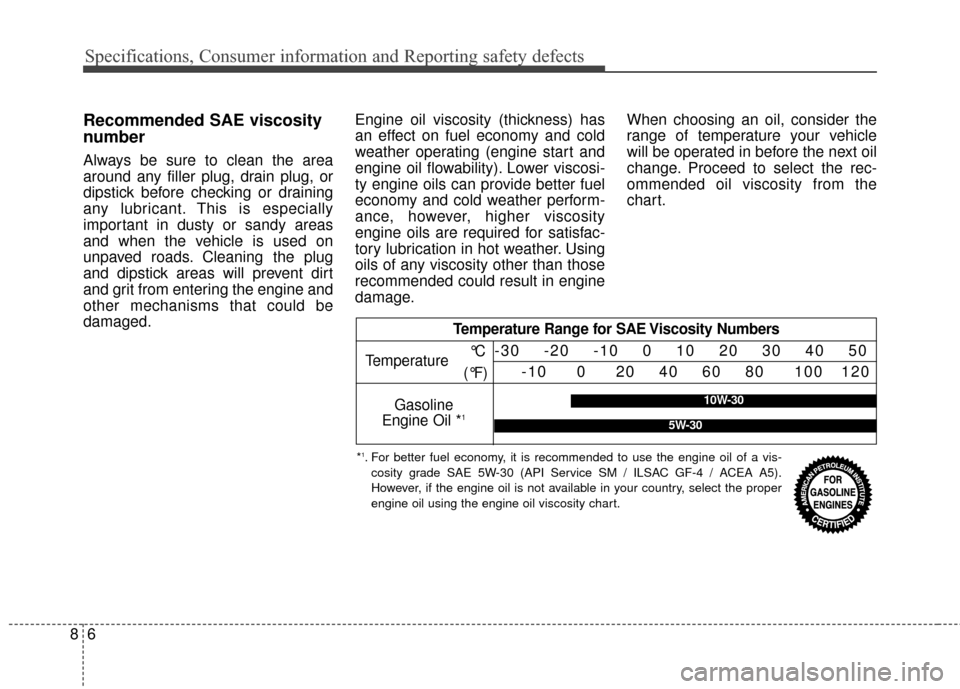
Specifications, Consumer information and Reporting safety defects
68
Recommended SAE viscosity
number
Always be sure to clean the area
around any filler plug, drain plug, or
dipstick before checking or draining
any lubricant. This is especially
important in dusty or sandy areas
and when the vehicle is used on
unpaved roads. Cleaning the plug
and dipstick areas will prevent dirt
and grit from entering the engine and
other mechanisms that could be
damaged.Engine oil viscosity (thickness) has
an effect on fuel economy and cold
weather operating (engine start and
engine oil flowability). Lower viscosi-
ty engine oils can provide better fuel
economy and cold weather perform-
ance, however, higher viscosity
engine oils are required for satisfac-
tory lubrication in hot weather. Using
oils of any viscosity other than those
recommended could result in engine
damage.
When choosing an oil, consider the
range of temperature your vehicle
will be operated in before the next oil
change. Proceed to select the rec-
ommended oil viscosity from the
chart.
Temperature Range for SAE Viscosity Numbers
Temperature
Gasoline
Engine Oil *
1
°C
(°F)-30 -20 -10 0 10 20 30 40 50 -10 0 20 40 60 80 100 120
*1. For better fuel economy, it is recommended to use the engine oil of a vis-cosity grade SAE 5W-30 (API Service SM / ILSAC GF-4 / ACEA A5).
However, if the engine oil is not available in your country, select the proper
engine oil using the engine oil viscosity chart.
10W-30
5W-30
Page 505 of 520
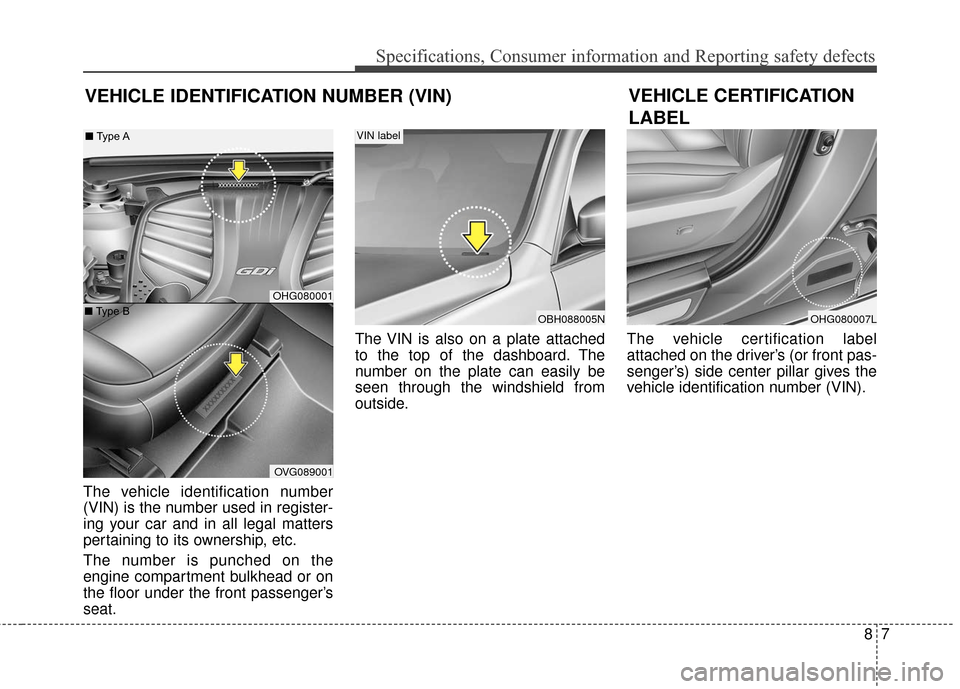
87
Specifications, Consumer information and Reporting safety defects
VEHICLE IDENTIFICATION NUMBER (VIN)
The vehicle identification number
(VIN) is the number used in register-
ing your car and in all legal matters
pertaining to its ownership, etc.
The number is punched on the
engine compartment bulkhead or on
the floor under the front passenger’s
seat.The VIN is also on a plate attached
to the top of the dashboard. The
number on the plate can easily be
seen through the windshield from
outside.
The vehicle certification label
attached on the driver’s (or front pas-
senger’s) side center pillar gives the
vehicle identification number (VIN).
OBH088005N
VIN label
OHG080007L
OHG080001
OVG089001
VEHICLE CERTIFICATION
LABEL
■
Type A
■ Type B
Page 506 of 520
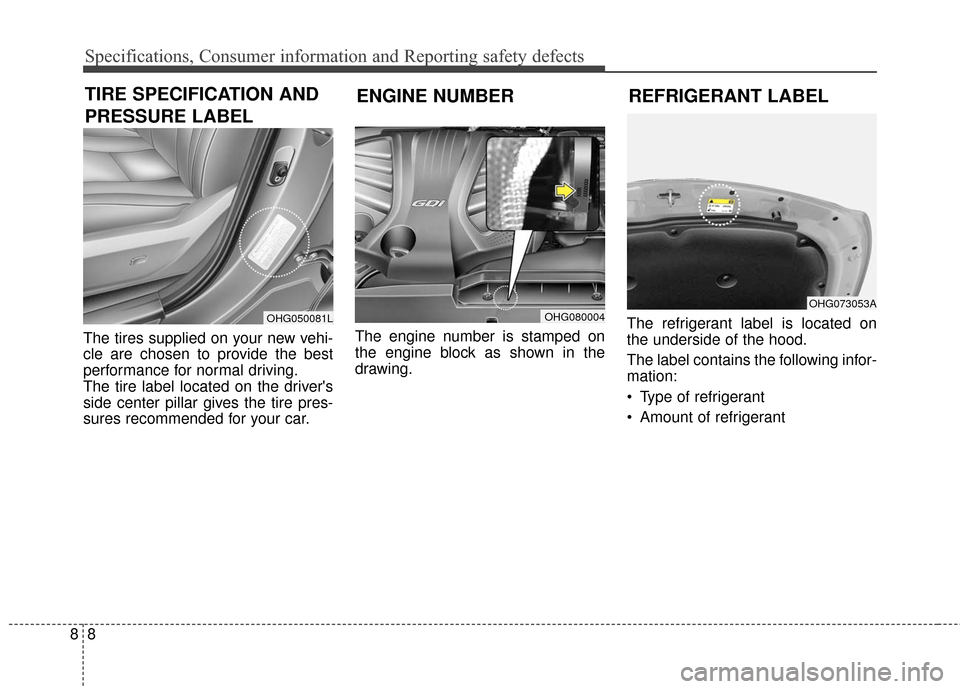
Specifications, Consumer information and Reporting safety defects
88
The tires supplied on your new vehi-
cle are chosen to provide the best
performance for normal driving.
The tire label located on the driver's
side center pillar gives the tire pres-
sures recommended for your car.The engine number is stamped on
the engine block as shown in the
drawing.
The refrigerant label is located on
the underside of the hood.
The label contains the following infor-
mation:
Type of refrigerant
Amount of refrigerant
OHG050081LOHG080004
ENGINE NUMBER
TIRE SPECIFICATION AND
PRESSURE LABEL
OHG073053A
REFRIGERANT LABEL
Page 507 of 520
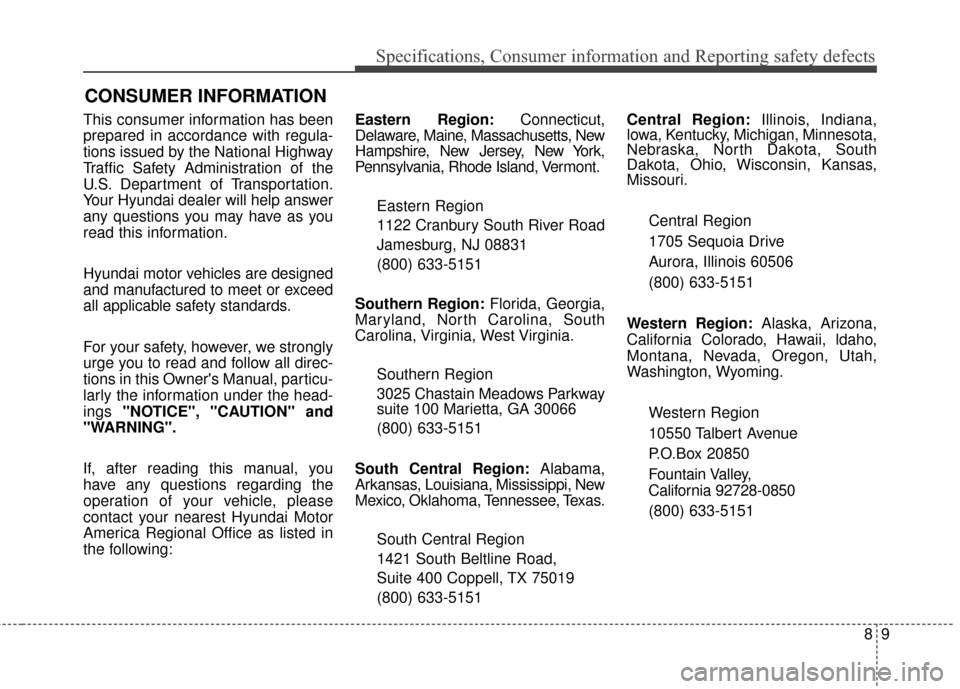
89
Specifications, Consumer information and Reporting safety defects
This consumer information has been
prepared in accordance with regula-
tions issued by the National Highway
Traffic Safety Administration of the
U.S. Department of Transportation.
Your Hyundai dealer will help answer
any questions you may have as you
read this information.
Hyundai motor vehicles are designed
and manufactured to meet or exceed
all applicable safety standards.
For your safety, however, we strongly
urge you to read and follow all direc-
tions in this Owner's Manual, particu-
larly the information under the head-
ings "NOTICE", "CAUTION" and
"WARNING".
If, after reading this manual, you
have any questions regarding the
operation of your vehicle, please
contact your nearest Hyundai Motor
America Regional Office as listed in
the following: Eastern Region:
Connecticut,
Delaware, Maine, Massachusetts, New
Hampshire, New Jersey, New York,
Pennsylvania, Rhode Island, Vermont.
Eastern Region
1122 Cranbury South River Road
Jamesburg, NJ 08831
(800) 633-5151
Southern Region: Florida, Georgia,
Maryland, North Carolina, South
Carolina, Virginia, West Virginia.
Southern Region
3025 Chastain Meadows Parkway
suite 100 Marietta, GA 30066 (800) 633-5151
South Central Region: Alabama,
Arkansas, Louisiana, Mississippi, New
Mexico, Oklahoma, Tennessee, Texas.
South Central Region
1421 South Beltline Road,
Suite 400 Coppell, TX 75019
(800) 633-5151 Central Region:
Illinois, Indiana,
lowa, Kentucky, Michigan, Minnesota,
Nebraska, North Dakota, South
Dakota, Ohio, Wisconsin, Kansas,
Missouri.
Central Region
1705 Sequoia Drive
Aurora, Illinois 60506
(800) 633-5151
Western Region: Alaska, Arizona,
California Colorado, Hawaii, ldaho,
Montana, Nevada, Oregon, Utah,
Washington, Wyoming.
Western Region
10550 Talbert Avenue
P.O.Box 20850
Fountain Valley,
California 92728-0850
(800) 633-5151
CONSUMER INFORMATION
Page 508 of 520
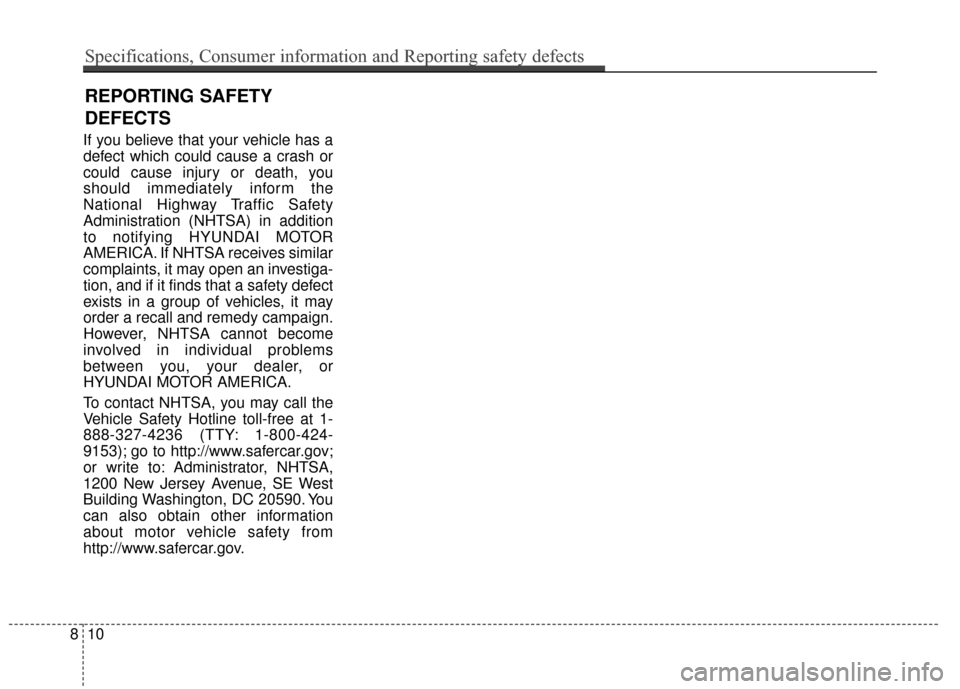
If you believe that your vehicle has a
defect which could cause a crash or
could cause injury or death, you
should immediately inform the
National Highway Traffic Safety
Administration (NHTSA) in addition
to notifying HYUNDAI MOTOR
AMERICA. If NHTSA receives similar
complaints, it may open an investiga-
tion, and if it finds that a safety defect
exists in a group of vehicles, it may
order a recall and remedy campaign.
However, NHTSA cannot become
involved in individual problems
between you, your dealer, or
HYUNDAI MOTOR AMERICA.
To contact NHTSA, you may call the
Vehicle Safety Hotline toll-free at 1-
888-327-4236 (TTY: 1-800-424-
9153); go to http://www.safercar.gov;
or write to: Administrator, NHTSA,
1200 New Jersey Avenue, SE West
Building Washington, DC 20590. You
can also obtain other information
about motor vehicle safety from
http://www.safercar.gov.
REPORTING SAFETY
DEFECTS
810
Specifications, Consumer information and Reporting safety defects
Page 509 of 520
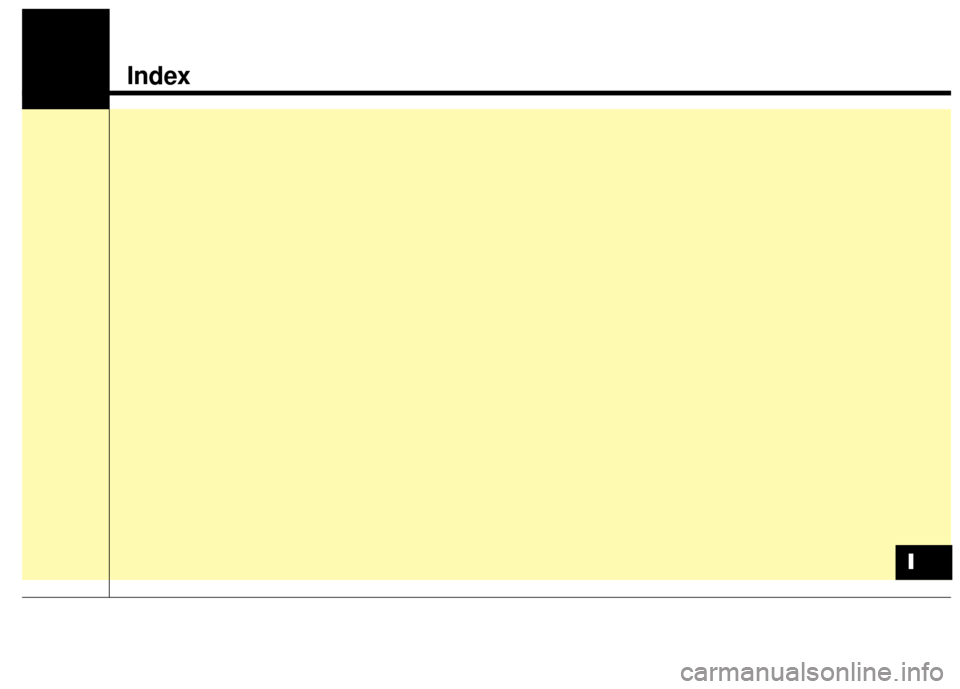
Index
I
Page 510 of 520
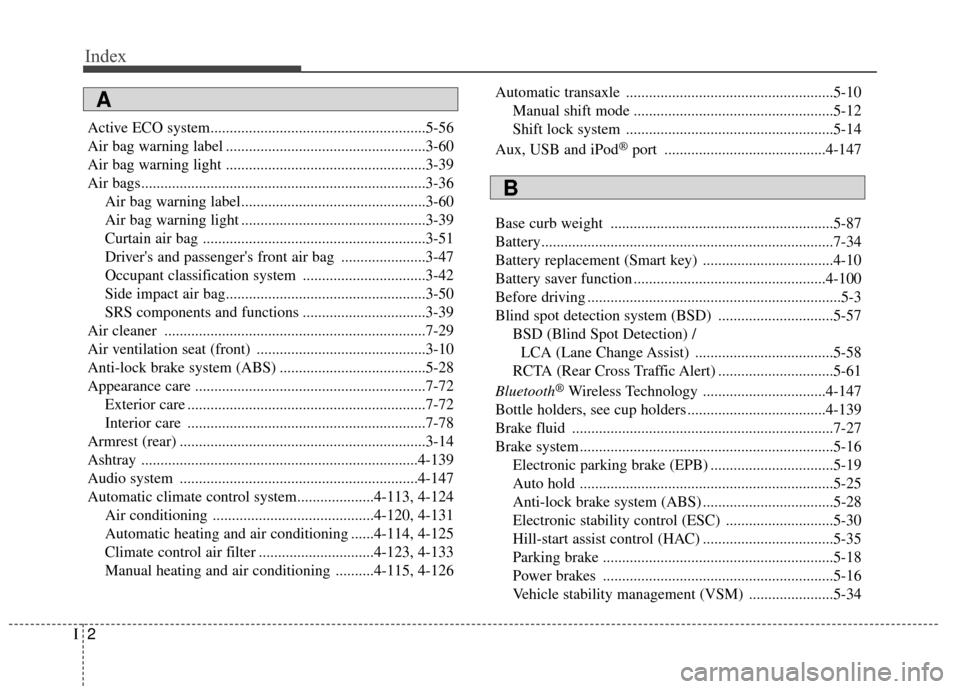
Index
2I
Active ECO system........................................................5-56
Air bag warning label ....................................................3-60
Air bag warning light ....................................................3-39
Air bags........................................................................\
..3-36Air bag warning label................................................3-60
Air bag warning light ................................................3-39
Curtain air bag ..........................................................3-51
Driver's and passenger's front air bag ......................3-47
Occupant classification system ................................3-42
Side impact air bag....................................................3-50
SRS components and functions ................................3-39
Air cleaner ....................................................................7-29\
Air ventilation seat (front) ............................................3-10
Anti-lock brake system (ABS) ......................................5-28
Appearance care ............................................................7-72 Exterior care ..............................................................7-72
Interior care ..............................................................7-78
Armrest (rear) ................................................................3-14
Ashtray ........................................................................\
4-139
Audio system ..............................................................4-147
Automatic climate control system....................4-113, 4-124 Air conditioning ..........................................4-120, 4-131
Automatic heating and air conditioning ......4-114, 4-125
Climate control air filter ..............................4-123, 4-133
Manual heating and air conditioning ..........4-115, 4-126 Automatic transaxle ......................................................5-10
Manual shift mode ....................................................5-12
Shift lock system ......................................................5-14
Aux, USB and iPod
®port ..........................................4-147
Base curb weight ..........................................................5-87
Battery........................................................................\
....7-34
Battery replacement (Smart key) ..................................4-10
Battery saver function ..................................................4-100
Before driving ..................................................................5-3
Blind spot detection system (BSD) ..............................5-57 BSD (Blind Spot Detection) / LCA (Lane Change Assist) ....................................5-58
RCTA (Rear Cross Traffic Alert) ..............................5-61
Bluetooth
®Wireless Technology ................................4-147
Bottle holders, see cup holders ....................................4-139
Brake fluid ....................................................................7-27\
Brake system..................................................................5-16 Electronic parking brake (EPB) ................................5-19
Auto hold ..................................................................5-25
Anti-lock brake system (ABS) ..................................5-28
Electronic stability control (ESC) ............................5-30
Hill-start assist control (HAC) ..................................5-35
Parking brake ............................................................5-18
Power brakes ............................................................5-16
Vehicle stability management (VSM) ......................5-34
A
B